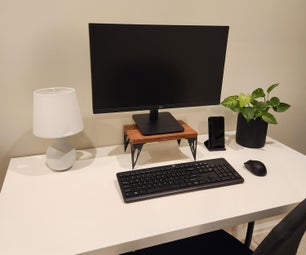Introduction: Double-slit Interference Experiment
A classic experiment to demonstrate the wave nature of light involves double-slit interference. Running the same experiment with a source that outputs just one photon at a time can demonstrate one of the weird features of quantum-mechanics -- wave/particle duality.
This Instructable uses a do-it-yourself single-photon source to set up and run this experiment at home.
NOTE 1: I am not going to simply copy the contents of the Wikipedia article into this I'ble. For the physics background, please read the article above, or your favorite freshman QM textbook.
NOTE 2: I am publishing this instructable without photos; I will update it, I hope, eventually with pictures for every step. However, I've found myself sending out the unpublished URL a few times, and I think it ought to be made public. Hopefully Robot agrees.
Step 1: Make a Two-slit Diffraction Grating
Get a piece of thick metal foil, about 2" square. Don't use tinfoil. A piece of aluminum can pressed flat will work fine, or a 2 mil brass shim. If you've ever made a pinhole camera, that's the sort of material you want to use.
Cut two parallel slits in the middle of the foil, about 1 mm (less than 1/16") apart. The tip of a utility knife pressed through will do the job well. The slits don't need to be long, but they do need to be parallel (otherwise the interference pattern will be hard to see).
Stand the foil up vertically. If you have a blob of modelling clay or Silly Putty that will work well to hold up the foil. A binder clip would also work nicely.
Step 2: Find the Diffraction Pattern
With your two-slit grating set up, you want to see that it works, and determine the optimal positions for your photon source and detector. Put a white screen (a piece of paper or business card) about 20 inches (50 cm) behind the grating, and a laser pointer a few inches in front of it.
Tape down the button on the laser pointer, and set it so that the spot is centered across the two slits, and the beam is "perfectly" horizontal. A miniature microphone stand or helping-hand can do this job, or another blob of modelling clay.
On the paper screen, you should see a pattern of laser-colored stripes (called fringes), brightest in the center and getting dimmer to either side. The spacing between the fringes is given by x = λL/d, where L=50 cm is the distance from the grating to the screen, d= 1 mm is the separation between the two slits, and λ=532 nm is the wavelength of the laser; with this setup, x=0.27 mm. That seems small, but it is enough to see. If you want wider separation between fringes, move the screen back.
Step 3: A Cumulative Photodetector
To do the single-photon version of this experiment, you need a cumulative photodetector. In the good old days, a simple piece of film would do the job, but that doesn't seem to exist any more.
A good quality SLR digital camera, with an "indefinite shutter" is what you need. A Webcam might work, if you can set it up for continuous capture instead of 30 Hz frames. Configure the camera in advance, but don't open the shutter until you've got everything set up in the dark.
Step 4: Configure for Quantum Weirdness
In front of the grating, set up your single-photon laser pointer with filter stack. Replace the screen with your photodetector (SLR camera or covered film). Turn on the laser (tape down the button), and turn off all the lights in your darkroom. Now open the shutter (or uncover your sheet of film) and wait.
If you are using a digital camera, you can watch the results unfold in real time. As each photon goes through the grating, you'll see one pixel light up on the output display. At first, they'll just seem like random hits scattered on the display, mostly in the center. But eventually, you will see that they're congregating in stripes, with regions where no pixels are ever getting hit.
You'll want to let this run as long as you have patience. Five or ten minutes is the minimum; an hour would be better. Eventually, your display will build up to show exactly the same kind of pattern of interference fringes as you saw before.
Step 5: What's So Weird About It?
So you ran the laser "really slowly" and got the same interference pattern as before. So what? If we were dealing with purely classical light waves, there wouldn't be an issue. We just turned down the intensity (amplitude), but they're still waves, so they still interfere. But there really is more to it than that.
As you saw when you looked at the single-photon source yourself, this isn't just low-intensity light. It comes in discrete, countable packets (flashes), called photons. Each photon has a definite energy (and they're all exactly the same), and it follows some specific trajectory, the same way a particle does.
If I shoot one particle at the grating, doesn't it have to go through either one slit or the other, maybe "bouncing" off the edge, and then hit the screen in some particular spot? If all that is random, then why don't we get a couple of blobs, one aligned with each slit, and fading away as you get farther from each slit?
Instead, the pattern we get is the pattern of a wave passing through both slits, and interfering. The points where the interference is positive (constructive) we get a lot of hits (a bright fringe), and where the interference is negative (destructive) we get nothing.
The "simplest" conclusion is that the wavefunction of each photon goes through both slits, interferes with itself, and we see the result. There are other interpretations, other mechanistic models for what's going on, but they're all peculiar in one way or another.













